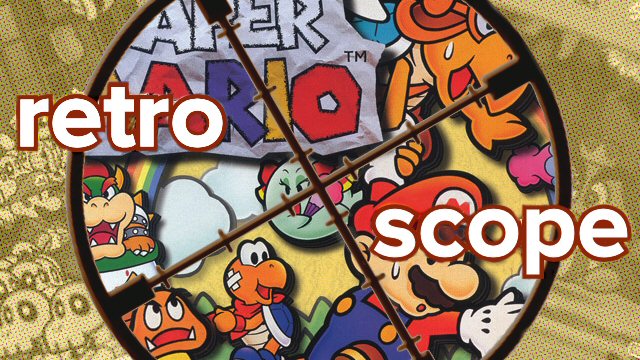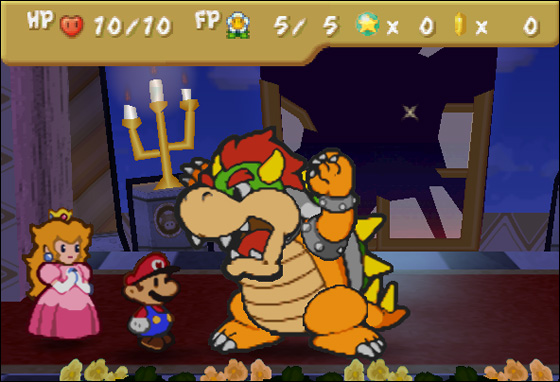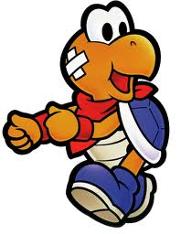
Paper Mario was originally going to be released as Super Mario RPG 2. However, by the time it was released in Japan in 2000 (and 2001 for Europe and North America) the title had changed, and for good reason. Just in case you’re unfamiliar with this game, Paper Mario attempted to find a tricky, perilous middle ground between the platforming wizardry of the earlier Mario titles and the epic RPG goodness of Super Mario RPG. For the most part it performs this balancing act with aplomb, but it can sometimes feel a little lightweight in terms of depth and difficulty, and it certainly falls considerably short of the game it was originally intended to follow. Miyamoto himself has said that the game was designed with younger, inexperienced players in mind and this certainly shows in the final product.
I’m not going to bother patronising you all with a synopsis of the story. Suffice to say, some giant, green lizard decides to kidnap an annoying blonde and a rotund, mustachio’d hero must save the day, yadda yadda yadda, and players must traverse the beautifully rendered jungles, deserts and snow levels that have become synonymous with the Mario universe.
 So, why Paper Mario I hear you cry? Well, whilst some of the backgrounds are 3D and have a wonderful depth of field, the characters themselves are 2D and paper thin, when viewed side on. This lends its visuals a wonderful, distinct flavour as the entire game essentially resembles one giant pop-up book. This theme is also integrated into the game structure as each section of the game is broken down into chapters or acts. But even though the game looks beautiful, even by today’s standards, I don’t believe the whole paper idea was ever utilised to its full potential in this game. This was, of course, rectified by the brilliant GameCube sequel, Paper Mario: The Thousand Year Door.
So, why Paper Mario I hear you cry? Well, whilst some of the backgrounds are 3D and have a wonderful depth of field, the characters themselves are 2D and paper thin, when viewed side on. This lends its visuals a wonderful, distinct flavour as the entire game essentially resembles one giant pop-up book. This theme is also integrated into the game structure as each section of the game is broken down into chapters or acts. But even though the game looks beautiful, even by today’s standards, I don’t believe the whole paper idea was ever utilised to its full potential in this game. This was, of course, rectified by the brilliant GameCube sequel, Paper Mario: The Thousand Year Door.
There are traditional platforming sections during which Mario can still run and jump, much as you would expect, but you cannot simply jump on a Goomba’s head to secure victory in this game. The RPG elements come into play during combat and it’s these sections which attempt to implement traditional RPG-type elements. Battles are turn-based and rely on the use and understanding of stats and various items. Mario will also encounter companions on his journey and each of these individuals bring different abilities and options into play, but it’s very much up to the player to decide which of these friends will be best-suited to a given situation. I absolutely applaud the developers for trying something new here, and these sections do work very well, especially when the ferocity of certain attacks depends on actual skill and timing in terms of when you must press certain buttons. As long as you’re not expecting to find complexity, grinding and endless, puzzling stats, you will probably be pleasantly surprised by this entry in the Mario series. Just keep in mind that the RPG elements are very watered down for the target market. Xenoblade Chronicles this is not!

Okay, the whole “our princess is another castle” spiel isn’t gonna wash this time.
I don’t want to dwell on the negatives because I do have a genuine affection for this title. It manages to make up for all of its shortcomings by relying on pure charm, magic and a sense of whimsy. Spending time with Paper Mario never brings anything less than total escapism. The bizarre cast of characters you’ll meet on your journey are all beautifully realised, and the interactions you have with them are genuinely amusing due to some top notch writing. I’ve already mentioned that the story is nothing special but you’ll encounter some sections which at least attempt to give the impression of a significant narrative. For example, each act of the game is preceded by a story driven section, during which you take control of Princess Peach and must navigate a way out of Bowser’s castle. These aren’t massively long or involving, but they do add a extra little something to proceedings.
 The music is up there with the very best of the Mario soundtracks, too, and perfectly compliments the bold, bright visual style of the game. As mentioned before, the environments are far from original, but they look fantastic, and its timeless style means the visuals have aged very well.
The music is up there with the very best of the Mario soundtracks, too, and perfectly compliments the bold, bright visual style of the game. As mentioned before, the environments are far from original, but they look fantastic, and its timeless style means the visuals have aged very well.
Basically, as long as you don’t expect too much from Paper Mario, you’ll be guaranteed to lose yourself in the Mushroom Kingdom and plow on relentlessly until you reach the end. That fact alone speaks volumes for the game’s positives. The game isn’t life changing; it doesn’t offer anything particularly new, but it is an honorable attempt to bring some variety to Mario’s world. It has a charm all of its own and you’ll find it just washes over you and makes you feel happy. In these days of war-torn battlefields and brutal virtual worlds, sometimes it’s nice to find solace in a game that makes you smile, and Paper Mario is that game.




 ShareThis
ShareThis







This is truely one of my favorite games. Too bad that the newest Paper Mario is no where as fun. Hopefully the next Paper Mario will feel like this and TTYD.